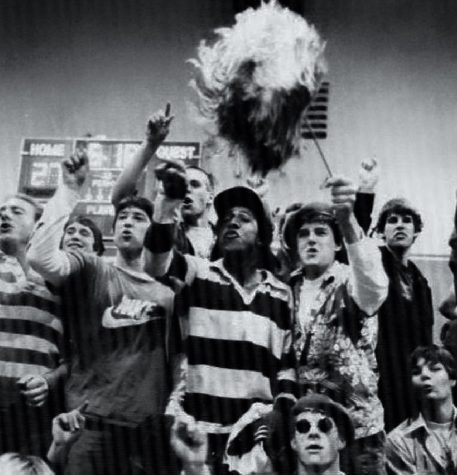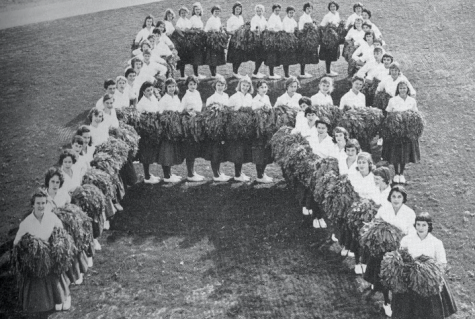The rivalry is still alive: A look into the evolution of sports rivalries at Redwood
December 13, 2021
After a full year of shortened sports seasons and strict spectator regulations, the competitive nature of Redwood sports are finally back in full swing along with buzzing spirit and, of course, the cherished school rivalries. The hallways are decorated with eye-catching posters advertising events and reminders of game times for the week. Games are bursting with spirited stands full of students and parents cheering for their Giants as they advance in their respective seasons. School rallies, themes and game nights are prominent in Redwood’s current sport culture; but is this how it’s always been?
Redwood first opened its doors in 1954, and due to a staggering population surge that caused an overflow of students in neighboring district high schools, they funneled students in from Tamalpais (Tam) High School and Archie Williams High School, causing a major increase in the student body. Marlee Rogers, the current co-President of the Redwood Alumni Association, was a student in the first graduating class of Redwood, and later became part of the faculty as a social studies and art teacher prior to her position on the Alumni Board. Rogers vividly remembers the cultural upbringing of the newly established Redwood High School.

“[The students] were busy trying to forge an identity,” Rogers said. “We were involved in picking the name of the school, the mascot and the yearbook … just trying to get it all going.”
Rogers reflected on the school spirit during her days at Redwood, recalling that the schools’ rivalries were mainly between Tam and Archie Williams. Due to the district overflow, students felt a strong allegiance to all three schools at the time, heightening the intensity of school rivalries in the area.
According to Rogers, the prevalence of sports games within the social atmosphere of Redwood also played a significant role in the amount of spirit shown by its students.
“When I was in school you were either [stereotypically popular] and you were in, or you were out … there wasn’t much else to do, so going to football games was just what we did on the weekends,” Rogers said.
Since Redwood’s sports programs were fairly limited when it first opened, the spirit and rivalries were heavily concentrated in the sports that were offered at the time: football, basketball and baseball.

“The spirit changed as [more teams were integrated]. Then there was more to be involved in sports-wise,” Rogers said.
Over time, Redwood’s rivalries became an integral part of its sports culture, drawing students to the stands on evenings, after school and on weekends. 1985 Redwood graduate and former varsity basketball player Matthew Blair vividly remembers his teams’ rivalry against Archie Williams and the vibrancy of the crowds during his games.
“Back in my day, there was a group called the ‘Unknown Animals’ who would paint their faces and come and cheer at basketball games,” Blair said. “[The rivalries] are what makes [playing] fun.”
Sue Chelini, a former Redwood teacher, Vice Principal and part-time District Athletic Coordinator, is reminiscent of the student spirit, especially in the 60s.
“The students were very [spirited] … kind of like Grease. We had song girls and would elect cheerleaders, which were boys and girls that led chants at games or rallies,” Chelini said.
While Redwood sports have experienced unbeatable success in the past, they have also had some defining lows. Chelini found that as the quality of the teams changed, so did the rivalries. During her time as an administrator, Chelini noted that in the 60s, there was no football rivalry against Marin Catholic High School (MC), which seems unheard of considering Redwood’s current, passionate feud against MC.
“When my brother went to MC in the 60s, [the football team was] terrible,” Chelini said. “My brother had no business being on a football team but he was a varsity starter.”

Similarly in the 90s, the football team could not even form a varsity team for the fall. Frustrated with their 85-3 loss against Novato high the previous year, along with other notable losses, most of the upperclassmen left the team.
“In the 90s, [at our] homecoming games we’d be lucky to get 25 Redwood students to come [because] it was usually just family members of the homecoming court … it wasn’t something kids clambered to do because the teams weren’t good,” Chelini said.
For Blair, the biggest changes in the rivalries today compared to his time at Redwood come from the gradual integration of club sports teams. These teams have connected students from various schools, cultivating a more personal, but still heavily competitive atmosphere.
“I think [the club teams] create even more of a friendship within a rivalry compared to back in the day when I didn’t really know anyone that I was playing against,” Blair said. “There’s more respect because of the history there.”

Although Redwood traditions have evolved over time, there is one that has remained constant: the Redwood spirit ball. The spirit ball was originally used as a method of weighing down nets under the Golden Gate Bridge to prevent submarines from entering the bay. After it was no longer needed in the 1940s, it was repurposed to become an iconic and beloved symbol of Redwood school spirit, engaging all students at Redwood.
“[The students] would say the spirit ball used to be half the size it is now because there are so many layers of paint on it,” Chelini said.
Blair recognizes the spirit ball as a long-standing representation of athletic rivalries.
“When I was at Redwood, some [rivalry teams] would even write on the spirit ball next to the football field,” Blair said.
In early March of 2020, Redwood experienced a more modern shift in its sports culture. With many sporting events canceled and occupation restrictions, as well as overall health concerns, increasing, Redwood students had little opportunity to support their school’s athletics. Blair, now with a son at Redwood, has witnessed a major turning point this year in the number of students and school-wide support.
“There’s some pent-up spirit post-[COVID-19] that I can see at the games I’ve been going to [this year],” Blair said. “It feels like there’s more of a community and I think that people are excited to go out and socialize because that was something we may have taken for granted in my day.”
Although Redwood sports have gone through their share of ups and downs, the traditions and rivalries generated in the 50s when Redwood’s doors first opened are still very much an essential part of the community today. Redwood and its students finally have the opportunity to show their support for one another and are simultaneously making their mark and setting precedents for the future of their school.